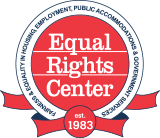History of the ERC
The Equal Rights Center was founded in 1983 as the Fair Housing Council of Greater Washington by Rev. Cameron Byrd, Rev. Dr. David Eaton, Rabbi Bruce Kahn, Msgr. Ralph Kuehner, Rev. James McDonnell, and Rev. Dr. John Peterson, with assistance from Rod Boggs of the Washington Lawyers’ Committee for Civil Rights and Urban Affairs. The timeline below charts the ERC’s history, highlighting the three organizations that eventually merged to create the ERC in its current form.
Key Events
Remembering ERC Leaders Rev. James Macdonell and Mr. James Gibson
Two civil rights advocates were at the forefront of the 1999 merger that formed the Equal Rights Center and were instrumental in the ERC’s subsequent successes: Reverend James Macdonell and Mr. James Gibson. Described as “soulmates” by those who knew them, Macdonell and Gibson dedicated their lives to fighting injustices throughout Washington D.C., the country, and the world. They contributed deeply to civil rights movements, both through their participation on the ERC’s Board of Directors as well as in their other individual personal and professional commitments.
Sadly, both men passed away in 2022. In the process of reflecting on their legacies, ERC staff and board members realized that there was an unmet need to document and preserve information about their contributions — both in order to honor them and so that present and future ERC stakeholders can benefit from the examples they set. As a result, the ERC has taken the initial step of creating this archive to honor their immeasurable contributions to the organization and to commemorate their important civil rights work. The archive includes excerpts from interviews conducted in 2023 with people who knew and worked closely with Rev. Macdonell and Mr. Gibson.
In its initial phase, the archive will focus on the lives and work of Rev. Macdonell and Mr. Gibson, though we hope to broaden its focus moving forward. We hope you’ll be inspired by the lives and legacies of these remarkable men, and that you’ll help us to advance their shared, ongoing mission by supporting the ERC.
This archive is an ongoing effort. We invite you to contribute by sharing your memories of Rev. Macdonell and Mr. Gibson with us.
Rev. James “Jim” Macdonell
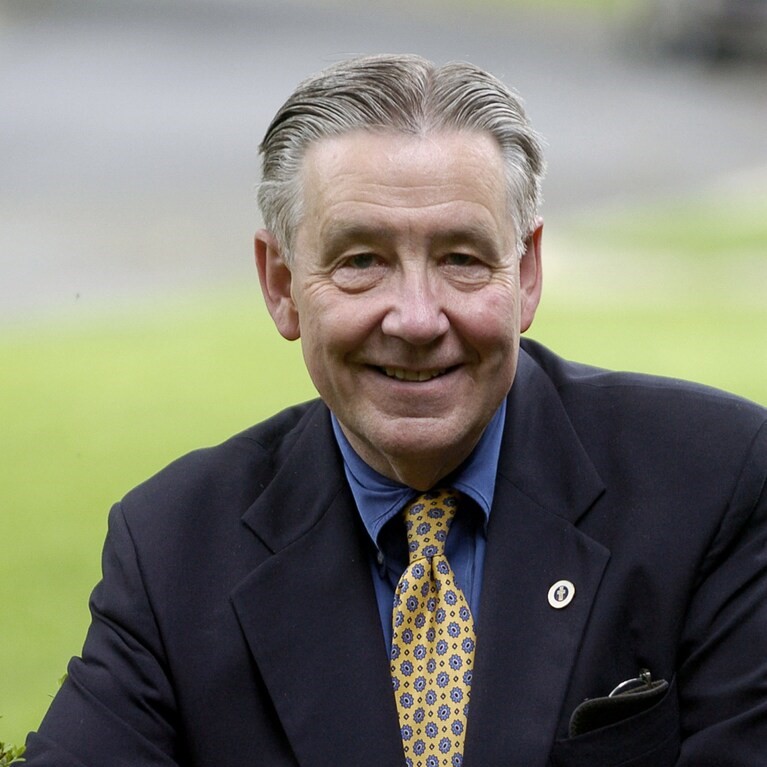
Rev. Jim Macdonell co-founded the Fair Housing Council of Greater Washington in 1983 and served as President of the organization’s Board of Directors for the next 30 years, through its merger with the Fair Employment Council and the creation of the Equal Rights Center. His record of civil rights advocacy, though, began long before that. In 1960, he founded Saint Mark Presbyterian Church in Rockville, Maryland, directing the congregation in service of the civil rights struggle. He participated in the 1963 March on Washington, and he was one of 25 Washington-area religious leaders who flew to the 1965 Alabama voting rights march from Selma to Montgomery, led by Dr. Martin Luther King Jr. He was also invited to Canton, Mississippi, with four other ministers to lead a registration drive for Black voters. In an interview with the Bethesda Patch, he described his time in Canton as the scariest 10 days of his life because of the threats he received. But he was bolstered by his fellow activists and their shared dedication to justice.
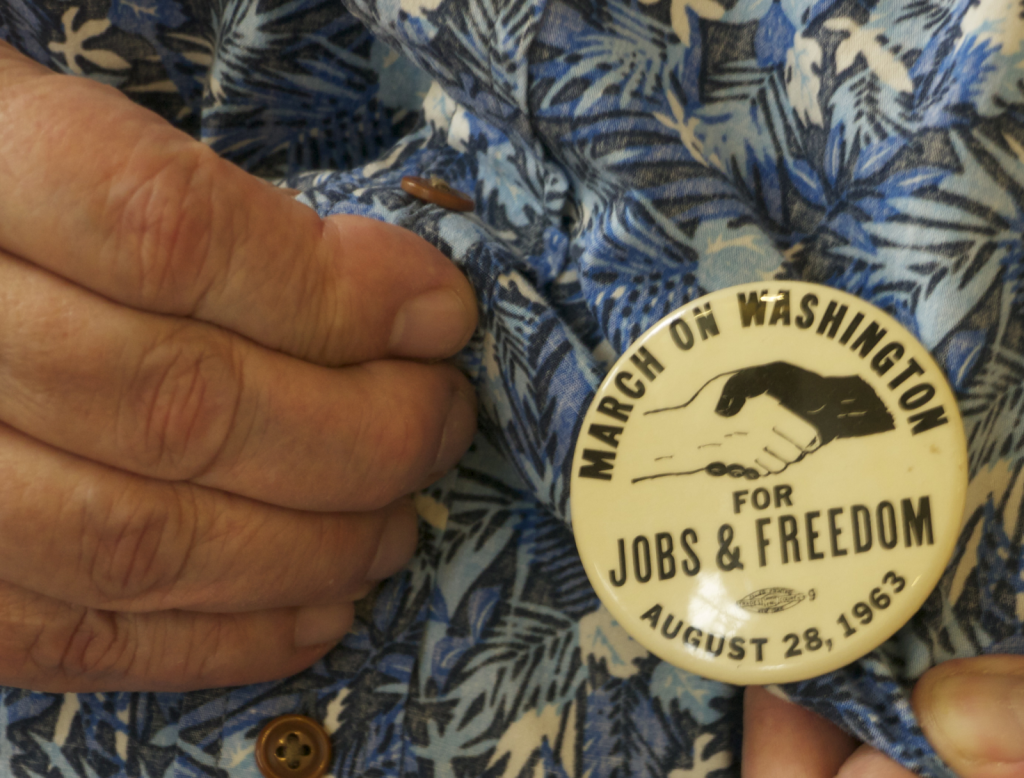
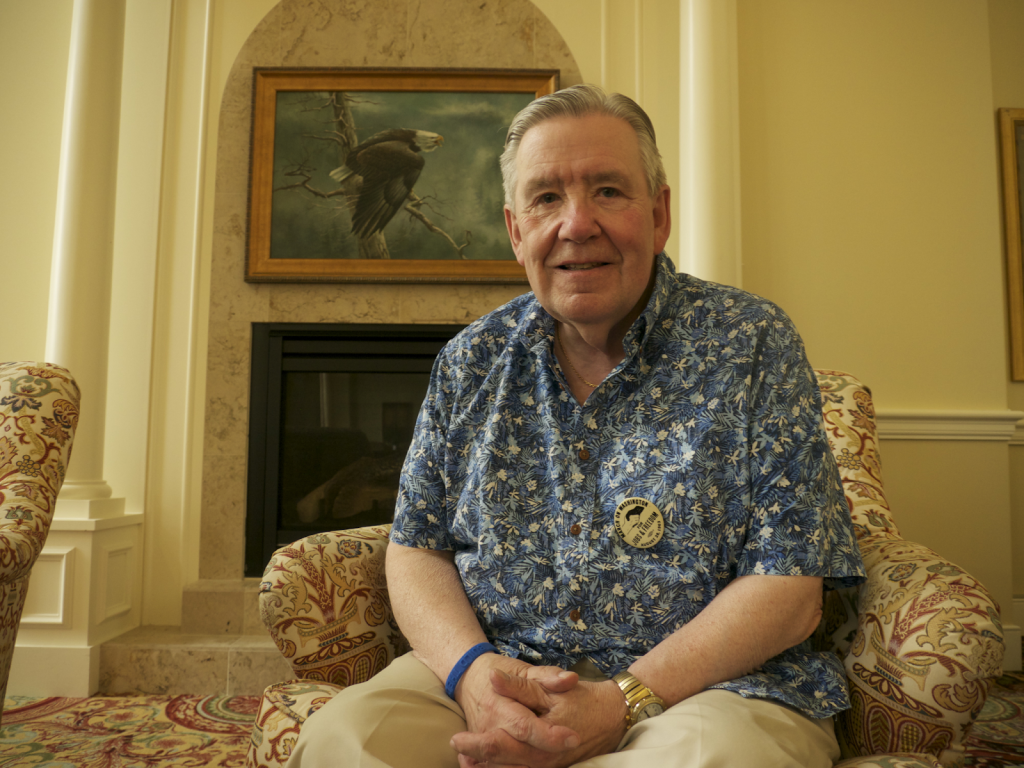 (Bethesda Patch)
(Bethesda Patch)
Rabbi Bruce Kahn, founding board member and former Executive Director of the ERC, and Rod Boggs, former Executive Director of the Washington Lawyers Committee for Civil Rights and Urban Affairs, both met Macdonell in 1983 when he was bringing the Fair Housing Council of Greater Washington into being. Both leaders remember feeling immediately impressed by Macdonell.
“I learned very quickly why he was asked to chair the board of the Fair Housing Council of Greater Washington,” said Kahn. “I was impressed to learn about him and his integrity, his passion, his love, and how he lived what he prayed, which is something that really matters to me. We just became very good friends as well as colleagues.”
In 1985, Kahn participated in a non-violent civil rights demonstration with Macdonell in front of the Soviet Union embassy in Washington. Kahn, Macdonell, and several of their colleagues ended up being sent to federal prison for two weeks.
“Jim loved that. He thought it was like he passed some kind of test that in his mind was super important,” Kahn said. “As close as we were before that, we became even closer after that.”

Rabbi Bruce Kahn presents Rev. Jim Macdonell with an award recognizing his thirty years of service to the Equal Rights Center. April 25, 2013.
When Boggs first met Macdonell at an event in Rockville, the two discussed the need for a fair housing group in D.C. that would use testers to investigate possible discrimination, and that the Washington Lawyers Committee could support. According to Boggs, they also developed the idea of inviting religious clergy, like Macdonell, to lead such an organization.
“[Religious leaders’] ability to apply a standard of morality and religion to the issue of discrimination, not just strictly legal interpretation, seemed to me to be quite helpful,” Boggs said, describing these preliminary discussions with Macdonell. “Before you know it, we had a group of five or six clergy who totally supported our organization.”
Boggs pointed to Macdonell’s peacemaking efforts in Northern Ireland during The Troubles as one of many examples displaying his dedication to fairness and equality. “You could see that he had a deep, deep commitment to equal rights,” said Boggs.
The Northern Ireland Bureau of Washington, D.C. honored Macdonell’s organization, the Presbyterian Committee on Northern Ireland, in 2012 for the Committee’s 20 years spent aiding the peace process to end the sectarian violence in Belfast and other parts of the region.
Macdonell was an exceptional cartoon artist as well. One of his many political cartoons about civil rights was published in the Washington Post in the late 1960s. He graduated from the American Academy of Art in Chicago in 1952 and briefly worked as a cartoon artist before changing career paths, but never stopped drawing on the side.

A political cartoon by Rev. Jim Macdonell criticizing a segregationist Maryland gubernatorial candidate. (Washington Post)
Later in life, Macdonell brought joy to the residents of his retirement home, Ingleside at King Farm in Rockville, by drawing caricatures that were published in the weekly newsletter. Macdonell created portraits and short biographies of the various residents and staff members he encountered at Ingleside. Eventually, the facility published a book of all the portraits he made, called “Ingleside Personalities.”
The Washington Post highlighted Macdonell’s cartoon work in a 2014 article. Macdonell brought people together and shared important stories even through his final years.
“He was such a gentle spirit, such a good person,” said Sue Marshall, ERC Board Secretary.
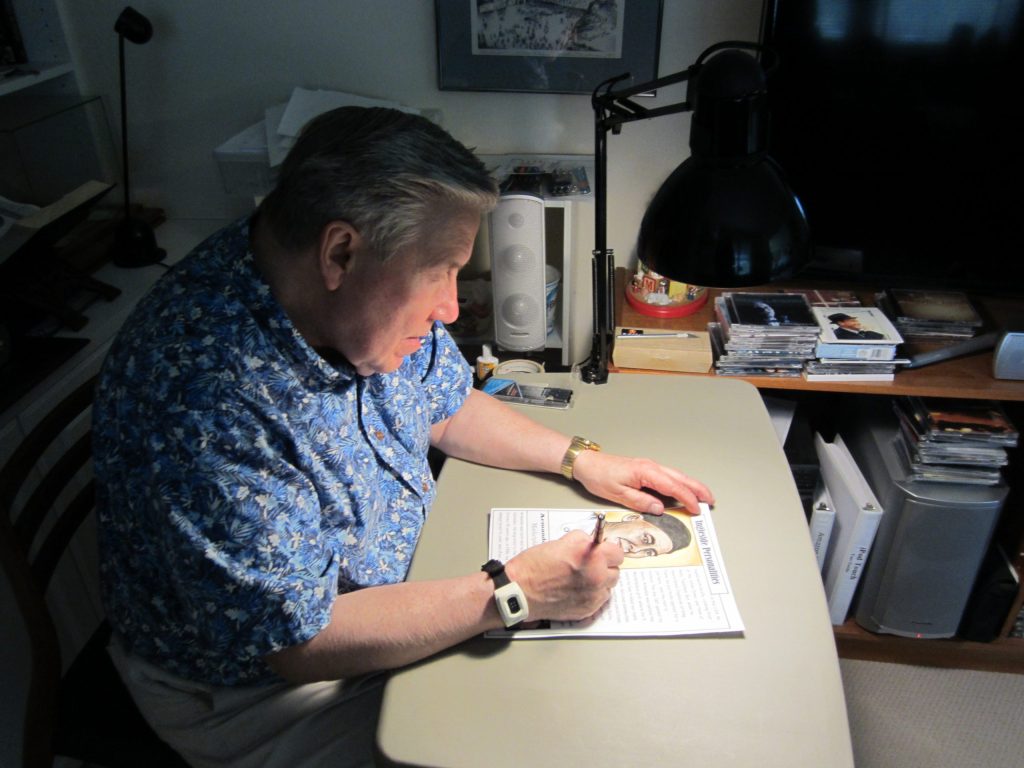
(Montgomery Community Media)
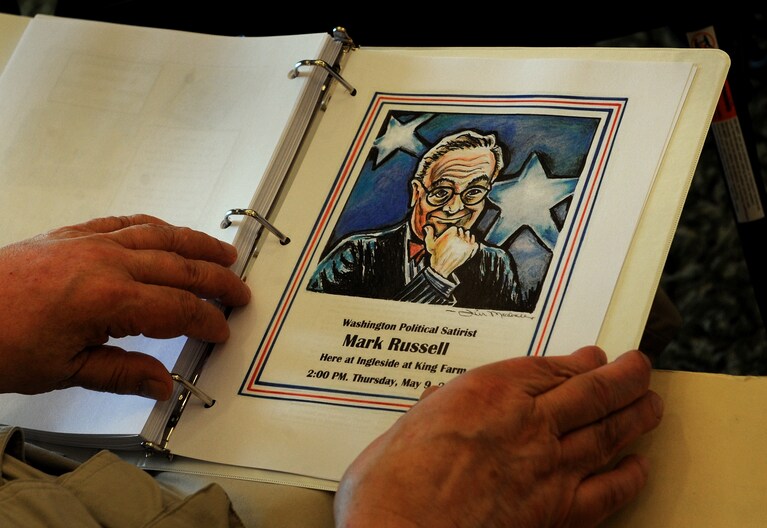
(Washington Post)
Mr. James “Jim” Gibson
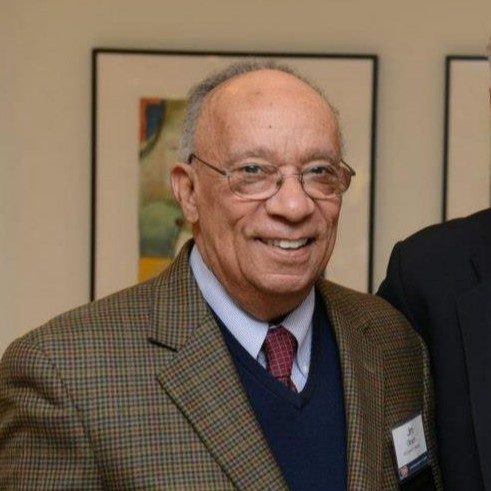
Everyone who knew Jim Gibson uses the same word to describe him: brilliant.
“He had an intellect that was almost scary. Thank God that it was all directed at solving horrible injustices. He was absolutely brilliant.” said Kahn. “There’s a line in an ancient Jewish text that says: ‘To sit at the feet of the wise, and drink in their words with thirst.’ That’s what I would do every chance I got with Jim Gibson.”
Kahn met Gibson in 1999 when the Fair Employment Council merged with the Fair Housing Council, forming the Equal Rights Center. But, like Macdonell, Gibson’s impressive civil rights record began much earlier than 1999.
After graduating from Duquesne University in Pittsburgh and then serving in the Army’s educational advisory program while stationed in West Germany, Gibson got involved with the civil rights movement in Atlanta. He was a co-chairman of the Atlanta Student Movement before serving as executive secretary for the Atlanta chapter of the NAACP. He also led the Planners for Equal Opportunity, a group of social scientists focused on ensuring that urban renewal efforts be more attentive to the needs of communities of color.
Throughout the 60s and 70s, Gibson was an executive associate at the now-defunct Potomac Institute, a nonprofit that worked towards policies promoting justice and equality, for 13 years.
He was appointed by President Lyndon B. Johnson to work at the District’s National Capital Planning Commission, but he resigned after one year in 1975 because he disagreed with the mayor’s funding plans.
Additionally, Gibson served as an advisor for Mayor Marion Barry, who was elected in 1979. That same year, Barry appointed Gibson as assistant city administrator for planning, which put him in charge of the Office of Planning and Development for three years.
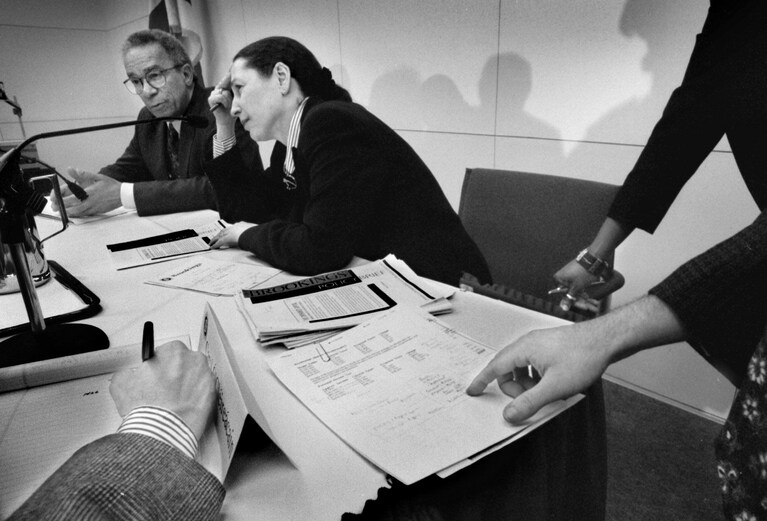
(Washington Post)
Gibson served in several roles during the years following his departure from city government, including President of the Meyer Foundation, Director of the Rockefeller Foundation’s Equal Opportunity Program, Senior Associate at the Urban Institute, Senior Fellow at the Center for the Study of Social Policy, and Director of D.C. Agenda.

(Video of Gibson speaking on C-SPAN for D.C. Agenda).
ERC Board Secretary and Executive Director of The Community Partnership for the Prevention of Homelessness Sue Marshall worked for the city in various roles, including as Vice Chair of the District’s Housing Finance Agency for eight years. She said she had always known about Gibson’s work around the city and with the Meyer Foundation. When she spoke with him in 1989 about The Community Partnership for the Prevention of Homelessness, she was pleasantly surprised that Gibson knew of her work.
“I remember more how exciting and empowering it was for me that somebody of Jim Gibson’s stature even knew who I was,” Marshall said. “And more relevant, that the work that the organization was doing was worthy of his interest and support.”
Gibson later joined The Community Partnership’s Board of Directors, and invited Marshall to join the ERC’s Board.
“Getting to know him, he was brilliant. One of the smartest people I have ever known, and equal parts a gentleman. And you don’t often find those two things together,” Marshall said. “He remained true to his gentlemanly character but was equally forceful and had such a strong intellect.”
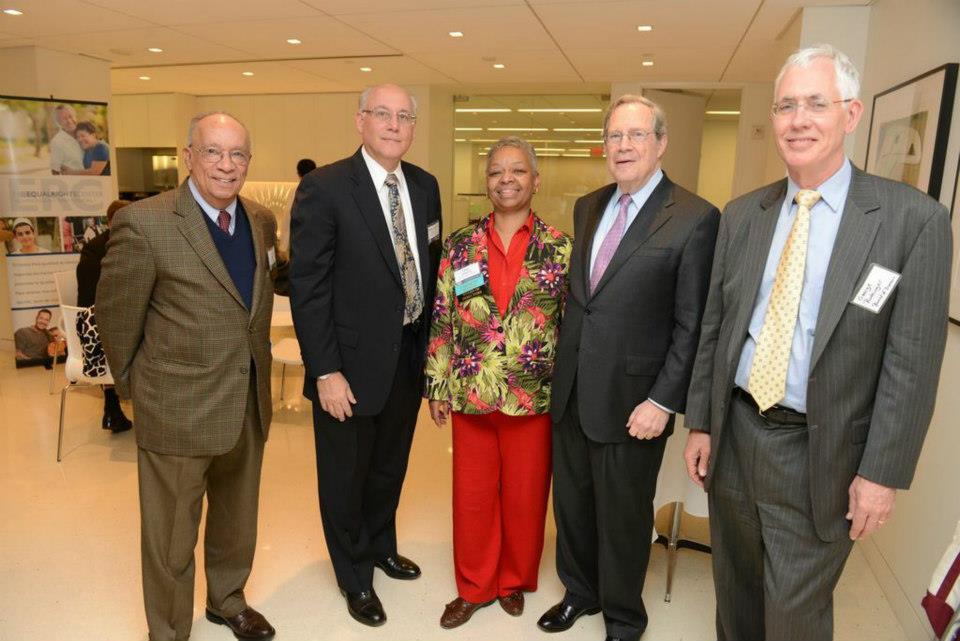
From left to right: Jim Gibson, Rabbi Bruce Kahn, Sue Marshall, Peter Edelman, and George Ruttinger at an ERC event in 2013.
Marshall, along with many others, considered Gibson a mentor and a friend. Kahn, who spoke at Gibson’s 80th birthday party, said, “The love that everyone there, family and friends, had for him was impossible to measure.”
“When I was the Executive Director of the ERC, even though we had known each other for a long time as so-called equals, I was never his equal,” said Kahn.
Rev. Macdonell and Mr. Gibson’s impact:
“These are two men who had a deep belief in equality and justice for everyone in this country, and who recognized that we had, unfortunately, a long history of not addressing these problems. They had the vision to see 40 years ago that to do something about it, people had to make these laws work that were being passed. The best way to make them work was to create an organization that would help to find problems and keep the problems at the forefront of public opinion, and when necessary, bring lawsuits to vindicate rights. That’s really what these organizations have done very effectively. It’s been a privilege to be a lawyer on their behalf. It’s the status of the organizations and people on the board like Jim Macdonell and Jim Gibson who have paved the way.”
“My main memory is the foresight and the level of commitment that they made to finding other people to do things, to address problems, to be public about their advocacy. I think, particularly, what they both did is to support the merger of these organizations and the use of the tool of testing to benefit an increased understanding of these issues. These are institution-building people. They were not after their own egos.”
-Rod Boggs, former Executive Director of the Washington Lawyers Committee for Civil Rights and Urban Affairs
“I believe that the legacy work that they did in civil rights informed how they behaved as advocates in other arenas. Certainly, to get the advances that were made in civil rights during the time that they were both prominent, it required [a special] kind of advocacy… They were both extremely situational in their abilities to size up situations and devise proper strategies. That there are not a whole lot of organizations like the Equal Rights Center, I think speaks to that point.”
“I don’t think there would be an Equal Rights Center but for their stewardship during the period I came onto the board… It was their leadership and commitment to the mission of the organization that brought me and some others onto the board and it’s what keeps me there… their fidelity to the mission of the organization. And that they were both very articulate that it was required public service of those of us who consider ourselves public servants. They were really good role models, is a good way to put it. Modeling the behavior that is required for change.”
-Sue Marshall, ERC Board Member and Secretary
“As a member of a younger generation in the ongoing fight for civil rights, I never had the pleasure of meeting either Rev. Macdonell or Mr. Gibson in person. But I’ve heard about the impact of their work for years — stories which were only amplified through the process of working on this archive. I am honored and inspired by their legacies to continue leading the work of the ERC, and committed to doing that work in ways that meet the high standards for integrity and justice that both men were known for.”
-Kate Scott, current ERC Executive Director
“Rev. Macdonell and Mr. Gibson were loved not only for their civil rights achievements, but also their character, and how they treated others. Each person I spoke with emphasized the integrity, passion, and kindness that both men possessed. This aspect is key to carrying on their legacies… I am hopeful that by educating the public about their work, we will inspire more people to get involved in civil rights activism.”
-Mary Kett, inaugural Macdonell/Gibson Intern
———
The ERC is a civil rights organization that identifies and seeks to eliminate unlawful and unfair discrimination in housing, employment and public accommodations in its home community of Greater Washington DC and nationwide. The ERC’s core strategy for identifying unlawful and unfair discrimination is civil rights testing. When the ERC identifies discrimination, it seeks to eliminate it through the use of testing data to educate the public and business community, support policy advocacy, conduct compliance testing and training, and, if necessary, take enforcement action. For more information, please visit www.equalrightscenter.org
